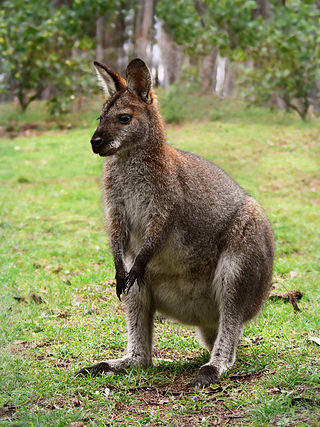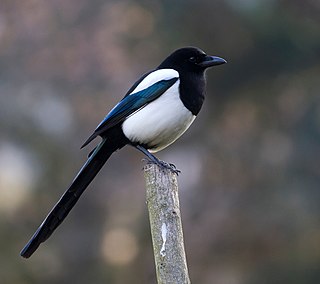
Eagle is the common name for the golden eagle, bald eagle, and other birds of prey in the family Accipitridae. Eagles belong to several groups of genera, some of which are closely related. True eagles comprise the genus Aquila. Most of the 68 species of eagles are from Eurasia and Africa. Outside this area, just 14 species can be found—two in North America, nine in Central and South America, and three in Australia.

Owls are birds from the order Strigiformes, which includes over 200 species of mostly solitary and nocturnal birds of prey typified by an upright stance, a large, broad head, binocular vision, binaural hearing, sharp talons, and feathers adapted for silent flight. Exceptions include the diurnal northern hawk-owl and the gregarious burrowing owl.
Genus is a taxonomic rank used in the biological classification of living and fossil organisms as well as viruses. In the hierarchy of biological classification, genus comes above species and below family. In binomial nomenclature, the genus name forms the first part of the binomial species name for each species within the genus.

In taxonomy, binomial nomenclature, also called binary nomenclature, is a formal system of naming species of living things by giving each a name composed of two parts, both of which use Latin grammatical forms, although they can be based on words from other languages. Such a name is called a binomial name, a binomen, binominal name, or a scientific name; more informally it is also historically called a Latin name. In the ICZN, the system is also called binominal nomenclature, "binomi'N'al" with an "N" before the "al", which is not a typographic error, meaning "two-name naming system".

Nightjars are medium-sized nocturnal or crepuscular birds in the family Caprimulgidae and order Caprimulgiformes, characterised by long wings, short legs, and very short bills. They are sometimes called goatsuckers, due to the ancient folk tale that they sucked the milk from goats, or bugeaters, their primary source of food being insects. Some New World species are called nighthawks. The English word "nightjar" originally referred to the European nightjar.

Moles are small mammals adapted to a subterranean lifestyle. They have cylindrical bodies, velvety fur, very small, inconspicuous eyes and ears, reduced hindlimbs, and short, powerful forelimbs with large paws adapted for digging.

Columbidae is a bird family consisting of doves and pigeons. It is the only family in the order Columbiformes. These are stout-bodied birds with short necks and short slender bills that in some species feature fleshy ceres. They primarily feed on plants, and can be taxonomically divided amongst granivores, that feed mostly on the ground on seeds, and frugivores, that feed mostly on fruits, from branches. The family occurs worldwide, often in close proximity with humans, but the greatest variety is in the Indomalayan and Australasian realms.

A partridge is a medium-sized galliform bird in any of several genera, with a wide native distribution throughout parts of Europe, Asia and Africa. Several species have been introduced to the Americas. They are sometimes grouped in the Perdicinae subfamily of the Phasianidae. However, molecular research suggests that partridges are not a distinct taxon within the family Phasianidae, but that some species are closer to the pheasants, while others are closer to the junglefowl.

A wallaby is a small or middle-sized macropod native to Australia and New Guinea, with introduced populations in New Zealand, Hawaii, the United Kingdom and other countries. They belong to the same taxonomic family as kangaroos and sometimes the same genus, but kangaroos are specifically categorised into the four largest species of the family. The term "wallaby" is an informal designation generally used for any macropod that is smaller than a kangaroo or a wallaroo that has not been designated otherwise.

Magpies are birds of the family Corvidae. Like other members of their family, they are widely considered to be intelligent creatures. The Eurasian magpie, for instance, is thought to rank among the world's most intelligent creatures and is one of the few nonmammalian species able to recognize itself in a mirror test. They are particularly well known for their songs and were once popular as cagebirds. In addition to other members of the genus Pica, corvids considered as magpies are in the genera Cissa, Urocissa, and Cyanopica.

Anseriformes is an order of birds also known as waterfowl that comprises about 180 living species of birds in three families: Anhimidae, Anseranatidae, and Anatidae, the largest family, which includes over 170 species of waterfowl, among them the ducks, geese, and swans. Most modern species in the order are highly adapted for an aquatic existence at the water surface. With the exception of screamers, males have penises, a trait that has been lost in the Neoaves. Due to their aquatic nature, most species are web-footed.

Cuckoos are birds in the Cuculidae family, the sole taxon in the order Cuculiformes. The cuckoo family includes the common or European cuckoo, roadrunners, koels, malkohas, couas, coucals, and anis. The coucals and anis are sometimes separated as distinct families, the Centropodidae and Crotophagidae, respectively. The cuckoo order Cuculiformes is one of three that make up the Otidimorphae, the other two being the turacos and the bustards. The family Cuculidae contains 150 species, which are divided into 33 genera.

Starlings are small to medium-sized passerine birds in the family Sturnidae. The Sturnidae are named for the genus Sturnus, which in turn comes from the Latin word for starling, sturnus. The family contains 128 species which are divided into 36 genera. Many Asian species, particularly the larger ones, are called mynas, and many African species are known as glossy starlings because of their iridescent plumage. Starlings are native to Europe, Asia, and Africa, as well as northern Australia and the islands of the tropical Pacific. Several European and Asian species have been introduced to these areas, as well as North America, Hawaii, and New Zealand, where they generally compete for habitats with native birds and are considered to be invasive species. The starling species familiar to most people in Europe and North America is the common starling, and throughout much of Asia and the Pacific, the common myna is indeed common.

Herons are long-legged, long-necked, freshwater and coastal birds in the family Ardeidae, with 72 recognised species, some of which are referred to as egrets or bitterns rather than herons. Members of the genera Botaurus and Ixobrychus are referred to as bitterns, and, together with the zigzag heron, or zigzag bittern, in the monotypic genus Zebrilus, form a monophyletic group within the Ardeidae. Egrets do not form a biologically distinct group from herons, and tend to be named differently because they are mainly white or have decorative plumes in breeding plumage. Herons, by evolutionary adaptation, have long beaks.

Old World monkey is the common English name for a family of primates known taxonomically as the Cercopithecidae. Twenty-four genera and 138 species are recognized, making it the largest primate family. Old World monkey genera include baboons, red colobus and macaques. Common names for other Old World monkeys include the talapoin, guenon, colobus, douc, vervet, gelada, mangabey, langur, mandrill, surili (Presbytis), patas, and proboscis monkey. Phylogenetically, they are more closely related to apes than to New World monkeys. They diverged from a common ancestor of New World monkeys around 45 to 55 million years ago.
In biology, a monotypic taxon is a taxonomic group (taxon) that contains only one immediately subordinate taxon. A monotypic species is one that does not include subspecies or smaller, infraspecific taxa. In the case of genera, the term "unispecific" or "monospecific" is sometimes preferred. In botanical nomenclature, a monotypic genus is a genus in the special case where a genus and a single species are simultaneously described. In contrast, an oligotypic taxon contains more than one but only a very few subordinate taxa.

In biological taxonomy, the type genus is the genus which defines a biological family and the root of the family name.

Acacia, commonly known as the wattles or acacias, is a large genus of shrubs and trees in the subfamily Mimosoideae of the pea family Fabaceae. Initially, it comprised a group of plant species native to Africa and Australasia. The genus name is Neo-Latin, borrowed from the Greek ἀκακία, a term used by Dioscorides for a preparation extracted from the leaves and fruit pods of Vachellia nilotica, the original type of the genus. In his Pinax (1623), Gaspard Bauhin mentioned the Greek ἀκακία from Dioscorides as the origin of the Latin name.

In biology, taxonomic rank is the relative level of a group of organisms in an ancestral or hereditary hierarchy. A common system of biological classification (taxonomy) consists of species, genus, family, order, class, phylum, kingdom, and domain. While older approaches to taxonomic classification were phenomenological, forming groups on the basis of similarities in appearance, organic structure and behaviour, methods based on genetic analysis have opened the road to cladistics.

The Solanaceae, or the nightshades, are a family of flowering plants that ranges from annual and perennial herbs to vines, lianas, epiphytes, shrubs, and trees, and includes a number of agricultural crops, medicinal plants, spices, weeds, and ornamentals. Many members of the family contain potent alkaloids, and some are highly toxic, but many—including tomatoes, potatoes, eggplant, bell and chili peppers—are used as food. The family belongs to the order Solanales, in the asterid group and class Magnoliopsida (dicotyledons). The Solanaceae consists of about 98 genera and some 2,700 species, with a great diversity of habitats, morphology and ecology.

















